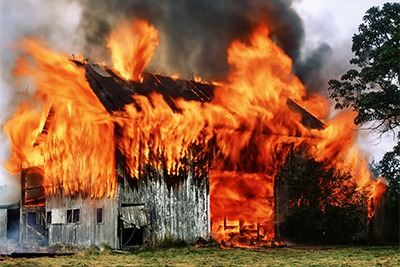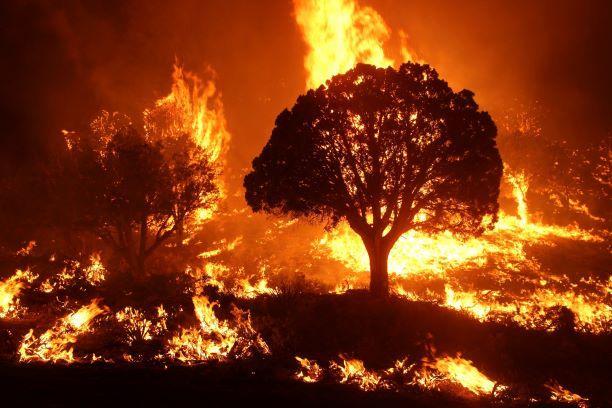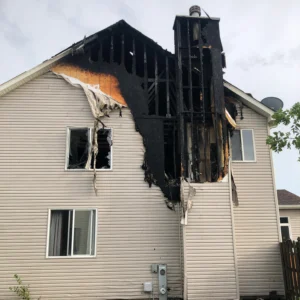Blogs
Assessing the Extent of Fire Damage: What to Look For

In the wake of a fire, the immediate aftermath is often overwhelming. The destruction can be profound, leaving property owners grappling with the daunting task of assessing the extent of fire damage. Beyond the obvious signs of charred structures, the true impact may lurk beneath the surface, presenting long-term risks and challenges. In this blog Intensa Dry aims to guide individuals through the crucial process of evaluating fire damage, offering insights into what to look for, hidden dangers, and steps to take for a comprehensive assessment. By understanding the nuances of fire damage assessment, property owners can make informed decisions on restoration and rebuilding efforts.
Understanding the Initial Signs:
The first step in assessing fire damage involves a thorough examination of the visible aftermath. Charred walls, melted materials, and the unmistakable scent of smoke are clear indicators of the fire’s path. However, a more nuanced approach is required to uncover the full extent of the damage. Begin by categorizing the affected areas based on the severity of the destruction. This initial classification will serve as a foundation for a more detailed assessment and help prioritize recovery efforts.
Structural Integrity and Safety:
In the aftermath of a fire, the assessment of structural integrity and safety becomes a paramount concern. The immediate and visible damage to buildings may only scratch the surface, as the intense heat of a fire can compromise the strength and stability of various structural elements. A comprehensive evaluation, typically conducted by qualified structural engineers, is necessary to determine the extent of the damage and assess the safety of the affected structures.
Structural damage resulting from a fire can manifest in several ways. The intense heat may cause steel to weaken, concrete to spall, and wood to lose its load-bearing capacity. It is imperative to inspect load-bearing walls, columns, and beams for any signs of distortion, cracking, or warping. Additionally, the foundation, a critical component of a building’s structural integrity, should be thoroughly examined for any shifts or cracks that may compromise stability.
One of the hidden dangers in assessing structural integrity is the potential for delayed effects. While some damage may be immediately evident, certain materials may undergo changes at a molecular level due to the exposure to high temperatures. This can weaken the overall structure, making it susceptible to collapse even after the fire has been extinguished. As such, a meticulous examination of all structural components, including those seemingly unaffected, is crucial.

Beyond the physical damage, the safety of individuals entering or working around the damaged structures is of utmost importance. Unstable walls, weakened floors, and compromised roofs pose immediate risks. Efficient professionals conducting the assessment should follow stringent safety protocols, including the use of personal protective equipment (PPE) and adherence to safety guidelines, to prevent accidents and injuries during the evaluation process.
In cases where the structural damage is severe, decisions regarding whether to repair or rebuild must be made. These decisions should be informed by the structural engineer’s assessment, considering factors such as the building’s historical significance, the cost-effectiveness of repairs, and compliance with current building codes. Understanding the long-term implications of structural damage is essential for making informed choices that prioritize the safety and well-being of occupants.
Moreover, the assessment should not be limited to the main structure alone. Detached structures like garages, sheds, or additional living spaces should also undergo thorough inspections. Even if these structures seem less critical, their stability is integral to overall safety and may impact the decision-making process for the entire property.
Water and Chemical Damage:
In the battle against flames, water and fire-retardant chemicals are often deployed to extinguish the fire. While effective in halting the spread of flames, these substances can inflict significant damage of their own. Waterlogged structures become breeding grounds for mold and mildew, posing health risks and exacerbating the destruction. Chemical residues, if not properly cleaned, can corrode materials and contribute to long-term hazards. A comprehensive assessment should include a thorough inspection for water and chemical damage, addressing these issues promptly to mitigate further deterioration.
Electrical Systems and Appliances:
Fire damage extends beyond the visible destruction, often infiltrating electrical systems and appliances. Even if flames do not directly reach these components, the intense heat can compromise wiring, circuitry, and other essential elements. A meticulous examination of electrical panels, outlets, and appliances is necessary to identify potential fire hazards. It is advisable to engage a qualified electrician to assess and address any issues, reducing the risk of electrical malfunctions that could trigger future fires.
Documenting and Cataloging Damage:
Accurate documentation is a critical aspect of the fire damage assessment process. Create a detailed inventory of damaged items, structures, and areas, accompanied by photographs and descriptions. This documentation serves multiple purposes, aiding in insurance claims, legal proceedings, and the overall recovery process. Pay attention to both visible and hidden damage, ensuring that no aspect is overlooked. The more comprehensive the documentation, the smoother the recovery journey will be.
Environmental Concerns:
Beyond the immediate physical damage, fires can have lasting effects on the environment. Smoke and ash residue may contaminate the air and soil, posing health risks to both humans and animals. Additionally, the destruction of vegetation can lead to soil erosion and other ecological imbalances. A holistic assessment should include an evaluation of environmental impacts, with appropriate measures taken to address and mitigate these concerns. Collaborate with environmental experts to ensure a thorough understanding of the broader consequences of the fire.
Environmental concerns following a fire extend beyond the immediate impact on structures and personal property. The aftermath of a fire can significantly affect the surrounding environment, potentially leading to long-term ecological consequences. Addressing these environmental concerns is crucial for holistic recovery and sustainable rebuilding efforts. Here are key aspects to consider:
- Air Quality:
The impact of a fire on air quality is significant and multifaceted. The combustion of various materials during a fire releases smoke and particulate matter into the air, which can have detrimental effects on respiratory health for both humans and animals. These airborne contaminants may persist even after the fire is extinguished, necessitating ongoing monitoring and assessment of air quality. Additionally, the burning of certain materials can release toxic substances, contributing to long-term environmental and health concerns. Therefore, understanding and addressing air quality issues are essential components of post-fire environmental management. - Soil Contamination:
Ash residue from a fire settles onto the ground, leading to potential soil contamination. Ash may contain harmful chemicals and heavy metals that pose risks to plant life, water sources, and wildlife. The loss of vegetation during a fire exacerbates the risk of soil erosion, as the stabilizing influence of plants is diminished. Consequently, addressing soil contamination becomes crucial for maintaining the fertility and ecological balance of the affected areas. Implementing measures to mitigate erosion and rehabilitate the soil, such as reforestation efforts, becomes imperative in the post-fire recovery process. - Water Quality:
Fires can have a profound impact on water quality through various mechanisms. Runoff from the fire-affected areas, laden with ash, debris, and contaminants, can compromise the quality of nearby water sources. The chemicals used in firefighting efforts can further contribute to water pollution. Monitoring and managing water quality post-fire are essential to safeguard aquatic ecosystems and prevent potential risks to human health. Implementing strategies such as sedimentation ponds and erosion control measures can help minimize the impact of runoff on water bodies, ensuring the resince of local aquatic environments. - Ecological Impact:
The ecological impact of a fire extends beyond the immediate destruction of vegetation and habitats. The loss of natural habitats and biodiversity is a consequence that requires careful consideration. Fires can disrupt ecosystems, leading to challenges in the recovery of plant and animal species. This loss of biodiversity not only affects the ecological balance but also poses challenges for species that rely on specific vegetation for their survival. Therefore, restoration efforts should address the broader ecological impact, considering the interdependence of species and their habitats. - Mitigation and Restoration:
Mitigating the environmental impact of a fire involves proactive measures aimed at restoring affected areas. Revegetation efforts, including reforestation with native plant species, play a crucial role in stabilizing soil, preventing erosion, and restoring habitats. Water management strategies, such as the creation of sedimentation ponds, can help control runoff and protect water quality. Additionally, wildlife rehabilitation efforts may be necessary to support the recovery of species affected by the fire. A comprehensive approach to mitigation and restoration is vital for fostering resilience and promoting the long-term health of ecosystems. - Long-Term Planning:
Building resilience against future fires requires a strategic and forward-looking approach. Implementing fire-resilient landscaping practices, such as using fire-resistant plant species and designing defensible spaces around structures, can mitigate the risk of future fires. Community education programs play a crucial role in promoting responsible land management and sustainable practices that contribute to overall ecosystem health. By integrating long-term planning into recovery efforts, communities can create environments that are better equipped to withstand and recover from future fire incidents, fostering a sustainable and resilient future.
Addressing environmental concerns in the aftermath of a fire requires collaboration between environmental experts, local authorities, and community members. By integrating environmental considerations into the recovery process, it is possible to not only rebuild what was lost but also foster a more sustainable and resilient future.
Health and Safety Precautions:
The aftermath of a fire often exposes individuals to various health and safety risks. Respiratory issues can arise from inhaling smoke and particulate matter, and exposure to mold and mildew can lead to allergic reactions. As part of the assessment process, prioritize the implementation of health and safety precautions. This includes the use of personal protective equipment (PPE) during inspections, proper ventilation to reduce airborne contaminants, and measures to prevent accidents in structurally compromised areas. Prioritizing health and safety not only protects those involved in the assessment but also lays the foundation for a secure recovery process.
Long-Term Implications and Future Prevention:
A comprehensive fire damage assessment goes beyond immediate recovery efforts; it lays the groundwork for long-term resilience. Consider the implications of the damage on the property’s future viability. Will certain materials need to be replaced with more fire-resistant alternatives? Are there changes to the building’s layout or design that could enhance fire prevention measures? These questions should guide the decision-making process as property owners embark on the journey of rebuilding. Collaborate with architects, builders, and fire safety experts to implement measures that reduce the risk of future fire incidents.

Conclusion:
Assessing the extent of fire damage is a multifaceted process that requires a careful balance of immediate action and strategic planning. By understanding the nuances of structural, environmental, and health-related impacts, property owners can navigate the challenges of recovery with greater efficacy. Engaging professionals, documenting damage comprehensively, and prioritizing long-term resilience are key components of a successful fire damage assessment. In the face of adversity, a systematic approach ensures that the path to recovery is not only thorough but also paves the way for a more resilient and secure future.
FAQ’s
How do you assess fire damaged concrete structures?
Evaluate fire damage in concrete structures by inspecting surface discoloration, cracks, and spalling. Engage structural engineers for in-depth assessments, considering both visible and potential hidden damage.
How would you describe fire damage?
Fire damage is the destructive aftermath of a fire, encompassing visible destruction like charred structures, melted materials, and the pervasive scent of smoke. It extends beyond the surface, potentially compromising structural integrity, introducing environmental hazards, and necessitating a comprehensive assessment to understand both immediate and latent impacts.
What type of damage does fire cause?
Fires cause visible damage like charring and melting, along with hidden issues such as structural compromise, water damage, and environmental repercussions. A comprehensive assessment is crucial to address the diverse impacts of fire.
How do you assess a fire incident?
Assessing a fire incident involves a systematic approach, examining visible damage, structural integrity, and potential hidden hazards. Engage professionals, document damage comprehensively, and prioritize safety to ensure a thorough evaluation guiding recovery efforts effectively.
What are the three fire safety tips?
- Install and test smoke alarms regularly.
- Create and practice a fire escape plan.
- Keep flammables away, use fire extinguishers, and ensure kitchen safety to prevent fires.

